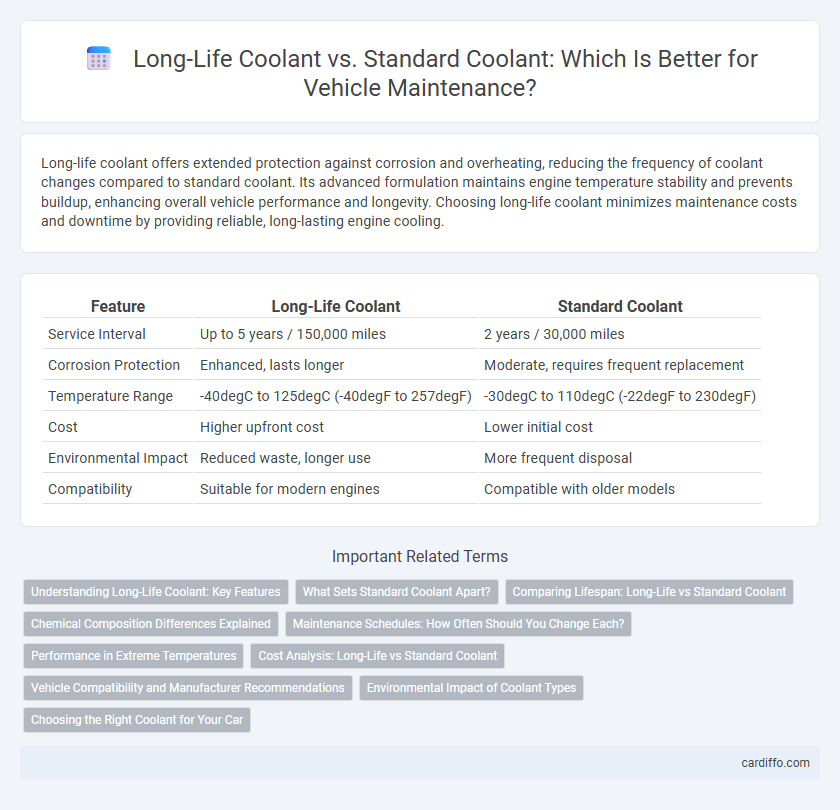Long-life coolant offers extended protection against corrosion and overheating, reducing the frequency of coolant changes compared to standard coolant. Its advanced formulation maintains engine temperature stability and prevents buildup, enhancing overall vehicle performance and longevity. Choosing long-life coolant minimizes maintenance costs and downtime by providing reliable, long-lasting engine cooling.
Table of Comparison
| Feature | Long-Life Coolant | Standard Coolant |
|---|---|---|
| Service Interval | Up to 5 years / 150,000 miles | 2 years / 30,000 miles |
| Corrosion Protection | Enhanced, lasts longer | Moderate, requires frequent replacement |
| Temperature Range | -40degC to 125degC (-40degF to 257degF) | -30degC to 110degC (-22degF to 230degF) |
| Cost | Higher upfront cost | Lower initial cost |
| Environmental Impact | Reduced waste, longer use | More frequent disposal |
| Compatibility | Suitable for modern engines | Compatible with older models |
Understanding Long-Life Coolant: Key Features
Long-life coolant offers extended protection against corrosion and overheating, typically lasting up to five years or 150,000 miles, compared to standard coolant's two to three years. Its advanced organic acid technology improves thermal stability and reduces the need for frequent coolant changes. This coolant type enhances engine performance by maintaining optimal temperature control and preventing rust buildup more effectively than traditional coolants.
What Sets Standard Coolant Apart?
Standard coolant is formulated with basic corrosion inhibitors and additives designed for shorter maintenance intervals and lower initial cost compared to long-life coolant. It typically requires more frequent replacement, usually every 2 years or 30,000 miles, to maintain optimal engine protection and prevent buildup of contaminants. Standard coolant is often recommended for older vehicles or those operating under less demanding conditions where extended coolant life is not critical.
Comparing Lifespan: Long-Life vs Standard Coolant
Long-life coolant typically lasts between 5 to 10 years or up to 150,000 miles, significantly outperforming standard coolant, which usually requires replacement every 2 to 3 years or 30,000 to 50,000 miles. The advanced additives in long-life formulations provide extended corrosion protection and thermal stability, reducing the frequency of coolant changes and maintenance costs. Choosing long-life coolant enhances engine longevity and ensures consistent performance over extended service intervals compared to standard coolant options.
Chemical Composition Differences Explained
Long-life coolant typically contains organic acid technology (OAT) which uses organic acids instead of traditional inorganic additives like silicates, phosphates, and nitrates found in standard coolant. This chemical composition reduces corrosion and extends the coolant's effective lifespan up to 5 years or 150,000 miles, compared to standard coolant's 2-year or 30,000-mile replacement interval. The absence of silicates and phosphates in long-life coolant minimizes deposits and enhances engine protection, making it a preferred choice for modern vehicles with extended service requirements.
Maintenance Schedules: How Often Should You Change Each?
Long-life coolant typically requires changing every 5 years or 150,000 miles, whereas standard coolant needs replacement every 2 years or 30,000 miles to maintain optimal engine performance and prevent corrosion. Adhering to manufacturer-recommended maintenance schedules prolongs radiator and water pump lifespan while avoiding costly repairs. Regular coolant checks ensure proper antifreeze concentration, temperature management, and system integrity for efficient vehicle operation.
Performance in Extreme Temperatures
Long-life coolant offers superior thermal stability and corrosion resistance, maintaining optimal engine temperature control in extreme heat and cold compared to standard coolant. Its advanced formulation reduces the risk of overheating and freezing, ensuring consistent performance in harsh climates. This extended durability helps prevent engine wear and extends maintenance intervals under challenging temperature conditions.
Cost Analysis: Long-Life vs Standard Coolant
Long-life coolant typically costs more upfront but offers extended service intervals, reducing the frequency of coolant changes and overall maintenance expenses. Standard coolant has a lower initial price but requires more frequent replacement, increasing labor and disposal costs over time. Evaluating total cost of ownership shows long-life coolant can be more economical for vehicles with high mileage or heavy-duty use, while standard coolant may be suitable for lower usage scenarios.
Vehicle Compatibility and Manufacturer Recommendations
Long-life coolant is formulated to provide extended protection for up to 5 years or 150,000 miles, making it ideal for modern vehicles with advanced cooling systems, while standard coolant typically requires replacement every 2 years or 30,000 miles. Vehicle compatibility depends on the coolant's chemical composition, such as Organic Acid Technology (OAT) in long-life coolants preferred by manufacturers like GM, and Hybrid Organic Acid Technology (HOAT) found in standard coolants used by Ford. Following manufacturer recommendations for coolant type ensures optimal engine performance, prevents corrosion, and maintains warranty coverage.
Environmental Impact of Coolant Types
Long-life coolant reduces the frequency of coolant replacement, decreasing hazardous waste and environmental pollution compared to standard coolant. It typically contains advanced corrosion inhibitors and organic acid technology that minimize toxic chemical runoff into ecosystems. Using long-life coolant supports sustainable vehicle maintenance by lowering the carbon footprint associated with coolant production and disposal.
Choosing the Right Coolant for Your Car
Selecting the right coolant for your car ensures optimal engine protection and longevity by maintaining stable operating temperatures and preventing corrosion. Long-life coolants offer extended intervals between changes due to advanced additives that enhance anti-corrosion and anti-freeze properties compared to standard coolants. Always consult your vehicle manufacturer's specifications to match coolant type and mixture for peak performance and warranty compliance.
Long-Life Coolant vs Standard Coolant Infographic

 cardiffo.com
cardiffo.com